Why Glycol Is Used for Cooling?

| Property | Ethylene Glycol | Propylene Glycol |
| Freeze point depression | more effective | less effective |
| Heat transfer efficiency/capacity | better | less |
| Viscosity | lower | higher |
| Flammability | low | low |
| Chemical oxygen demand | low | higher |
| Biodegrading | degrades in 10-30 days | needs more than 20-30 days to degrade |
| Carcinogenic | no | no |
| Toxic | high level of acute when taken orally, targets the kidneys | lower level of acute |
| Skin irritant | low | low |
The most commonly used coolant in a chiller is water or a mixture of water and another substance with appropriate heat conduction properties – such as a glycol compound. Glycol-based coolants consist of either ethylene glycol or propylene glycol. The main advantage of glycol coolants is their anti-freeze properties. Pure water freezes at 0 degrees C, while 30% ethylene glycol freezes at -14 degrees C. The low freezing point of glycol mixtures makes them ideal for cooling items that are below the freezing point of water. Although glycol has a lower heat capacity than water (each kilogram of glycol is easier to heat than one kilogram of water), the larger temperature difference allows the glycol mixture to remove heat more quickly than pure water. The glycol mixtures are more suitable for applications where the chiller must quickly remove large amounts of heat. In addition to providing excellent heat transfer parameters, glycol tends to discourage algae growth in heat transfer equipment.
How Does A Glycol System Work?
A chiller is a machine that removes heat from a liquid. This liquid can then be circulated through a heat exchanger(or a cooling jacket) to cool the equipment, another process stream, or just to be used. At the heart of a glycol system is the glycol chiller. Glycol chiller, as the name implies, uses glycol as the chiller’s cooling medium. A glycol chiller consists of a compressor, an evaporator, a condenser, a throttling element, and an electric control system. Let’s see what’s the working principle of a glycol chiller: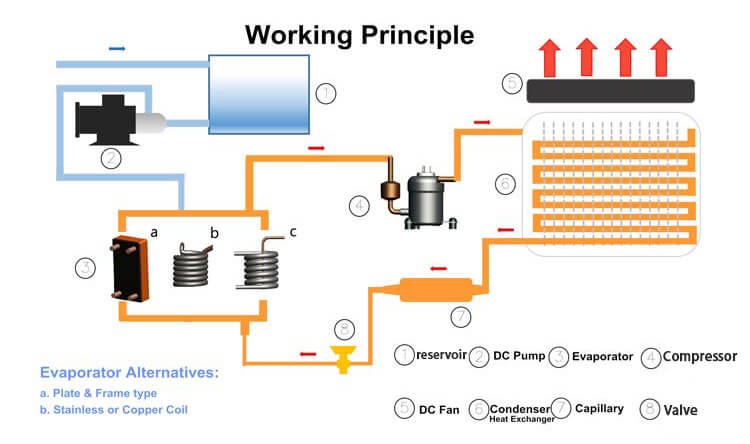
The chiller’s refrigerant absorbs thermal energy from your process, usually, the refrigerant will be turned into gas. The gaseous refrigerant is then circulated to a condenser which expels the heat through evaporative condensation. This heat exchange condenses the refrigerant back into a cooler gas& liquid mixture that is sent back to the process heating source to begin the cycle again.
The Ratio of Water to Glycol to Use
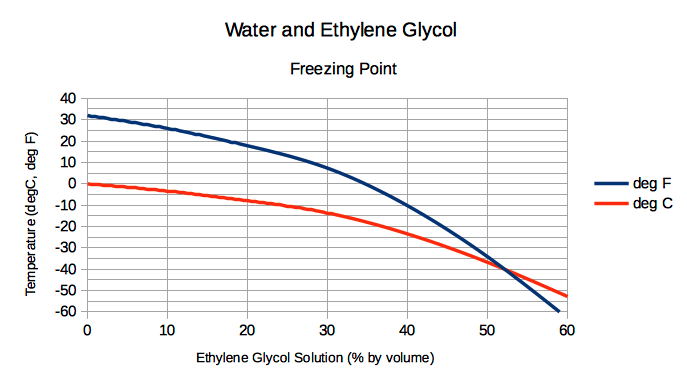
Calculating the proper ratio of glycol to water in a refrigeration system depends on the coldest temperature you need during operation. If the refrigeration system is used indoors, where there is a lower chance of freezing, the amount of glycol required will be significantly less than a glycol chiller used outdoors. it is very important to use the correct ratio of glycol to water in the chiller system. Adding too much glycol to a chiller system will result in an inefficient system. However, insufficient glycol can cause the system to freeze, possibly bursting pipes and even destroying the chiller evaporator.
Check the most used glycol ratio chart:
| Glycol | Water | Coldest Temperature |
| 16% | 84% | 0℃ |
| 24% | 76% | -5℃ |
| 32% | 68% | -10℃ |
| 40% | 60% | -15℃ |
| 45% | 55% | -20℃ |
| 50% | 50% | -25℃ |
| 55% | 45% | -30℃ |
What Can A Glycol Chiller Be Used For?
Glycol chillers are most used for chemical processing, pharmaceutical formulation, food and beverage processing.
| Glycol Chiller Applications | How Glycol Chillers are Being Used |
| Breweries | Cooling the Wort |
| Controlling Fermentation | |
| Crash Cooling Vessels | |
| Prepackaging | |
| Product Storage | |
| Wineries | Fermentation Process |
| Cold Stabilization | |
| Room Cooling | |
| Cider Mills | Fermentation Control |
| Cold Chilling the Juice | |
| Cold Storage of the Final Product | |
| Distilleries | Fermentation Process |
| Circulation Between Distillation Tanks & Stills | |
| Heat Removal |
Breweries
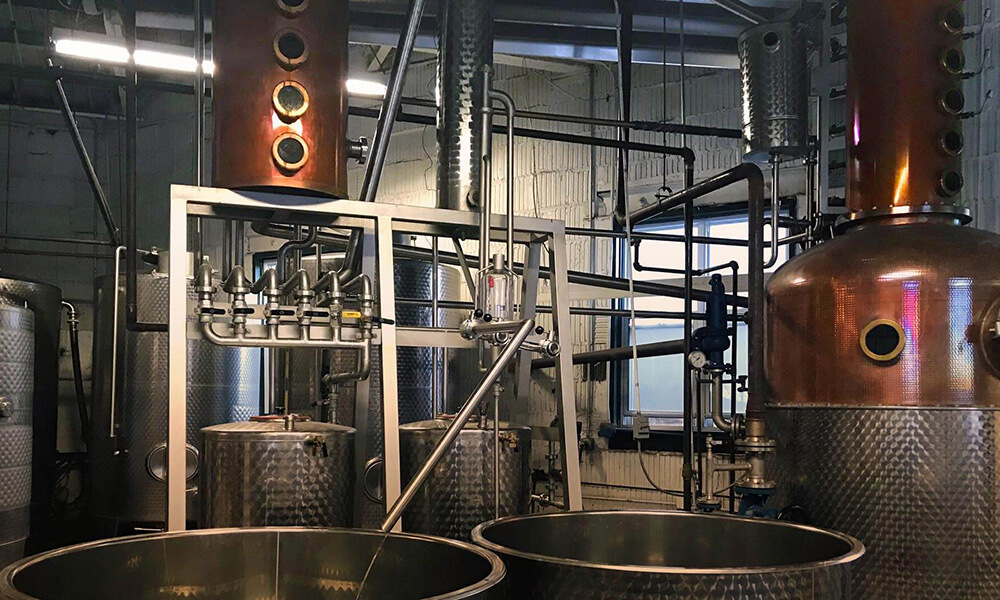
In breweries, using a glycol chiller allows producers to lower the temperature of the product dramatically over a short period of time, depending on the production needs. For cooling in brewing, there are several processes in which it is important to lower or maintain the temperature – such as cooling the beer sharply after fermentation, maintaining a steady temperature during fermentation (which generates heat), or cooling the wort after the initial boiling process.
Wineries
Winery chillers are used in the fermentation process of winemaking to control the temperature during fermentation. The temperature of the glycol solution varies depending on the type of wine being made and each winemaker’s preference, but most winery chillers operate in the 2 Deg C to 10 Deg C range (7 Deg C to 15 Deg C for wine containers).
Ice Rink
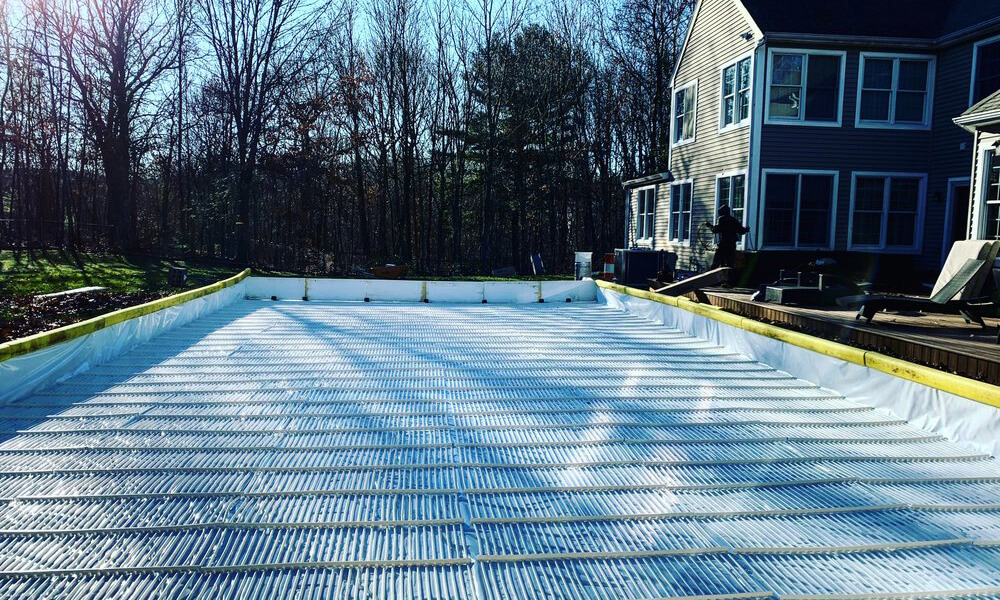
A glycol chiller takes advantage of this fact by chilling liquid glycol solution to well below the freezing point of water while pumping it through mats that are below the ice rink surface. These mats are then sprayed with water causing the water to freeze around and above the mats.
Dairy Product
A properly designed dairy glycol chiller can cool the milk very rapidly to help keep milk temperatures (and bacteria growth) under control as it is transferred from the milking parlor to its insulated tank.
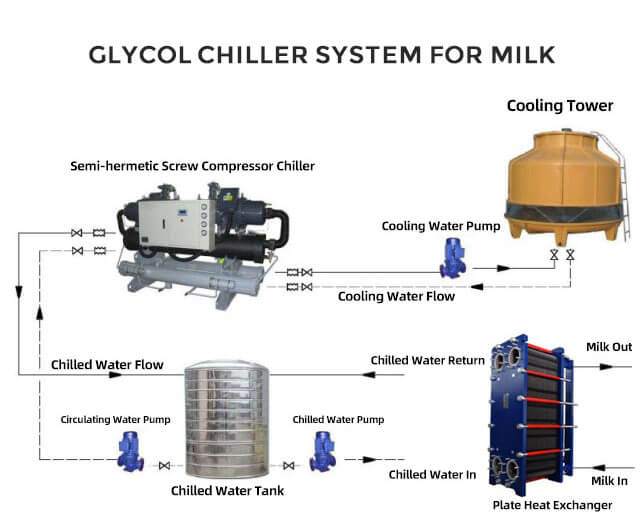
In addition to the above items, glycol chillers can be widely used in rubber, plastic, petroleum, chemical, electronics, paper, textile, brewing, pharmaceutical electroplating, central air conditioning and many other fields.
How To Choose The Right Capacity Of A Glycol Chiller?
From the above information, we will know the important role played by glycol chillers is not only in industry but also in commercial applications.There are some useful tips for sizing your glycol chillers:
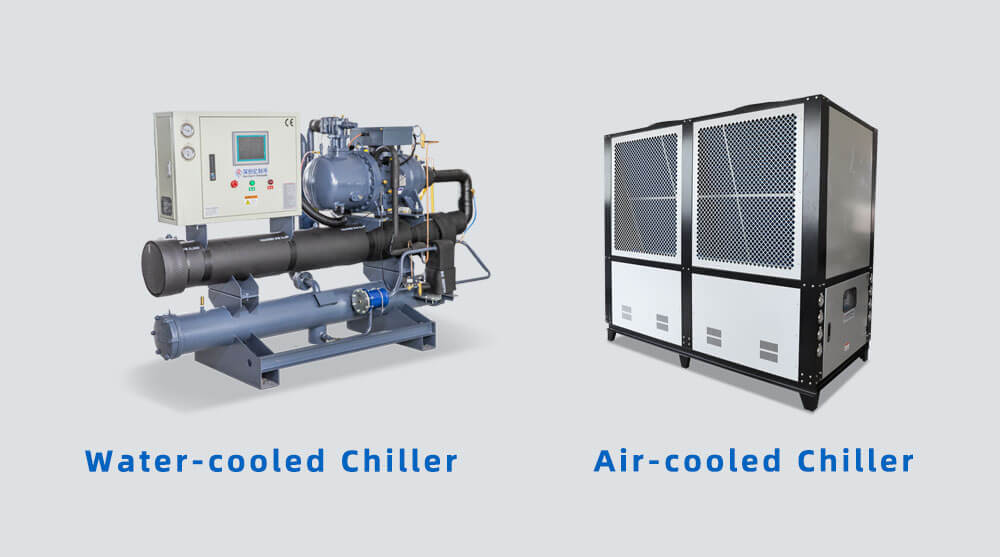
1. Air-cooled Or Water-cooled
Air-cooled chillers use a condenser that is similar to the “radiators” in a car. They use a fan to force air through the refrigerant coil. Unless they are specifically designed for high ambient conditions, air-cooled condensers need to operate effectively at an ambient temperature of 35°C (95°F) or less.
Air-cooled chillers require less maintenance than water-cooled chiller units.
Advantages of air-cooled chiller:
- Air-cooled chillers do not require cooling towers.
- Easier to install compared with a water-cooled chiller.
Water-cooled chillers function in the same way as air-cooled chillers but require two steps to complete the transfer of heat. First, heat enters the condenser water from the refrigerant vapor. The warm condenser water is then pumped to the cooling tower, where the heat from the process is eventually vented to the atmosphere.
Advantages of water-cooled chiller:
- Higher COP(Coefficient Of Performance).
- Lower cost on power for the same cooling capacity.
- Have a longer lifespan.
- Relatively quieter than air-cooled chillers.
- Provide more consistent cooling performance.
2. Cooling capacity
How to calculate the cooling capacity I need? Let’s see the below formula.
- Calculate Temperature Differential = Incoming Water Temperature (°c) – Outlet Chilled Water Temperature(°c)
- Water flow rate that you need per hour(m³/hour)
- Get in tons of cooling capacity = Water Flow Rate x Temperature Differential ÷ 0.86 ÷ 3.517
- Oversize the chiller by 20% Ideal Size in Tons = Tons x 1.2
- You have the ideal size for your needs.
Fill out our quick sizing form and we will be able to provide you with the glycol chiller selection customized to your process.
If you are not sure how to choose the cooling capacity, please contact us.
3. Whether A Built-in Tank Is Necessary

In a chiller system, a tank is usually equipped to buffer the thermal load of the chiller. But should we choose a built-in type of tank or an external type of tank? A chiller with a built-in tank is easier to install and can be used simply by connecting a water pipe to your application. But it has a limited capacity and is not suitable for applications with larger chilled water demands. The external tank’s capacity can be customized according to specific needs. It can buffer a larger heat load, and store more chilled water, but the installation will be more troublesome.
4. Water Flow
The water flow of a glycol chiller is mainly controlled by the pump, so you can choose a pump with different flow rates according to your specific needs.

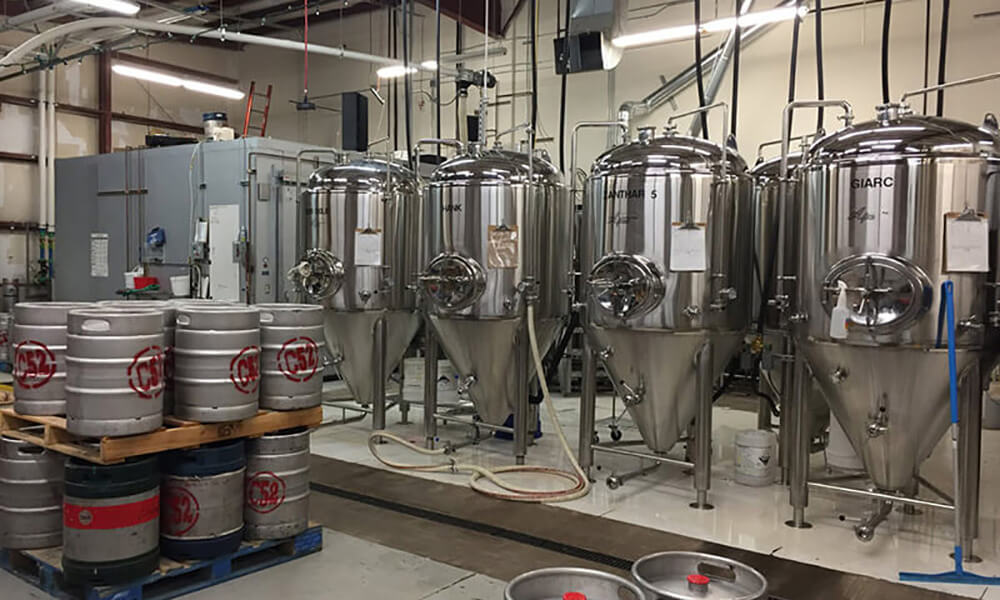

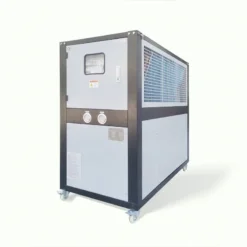
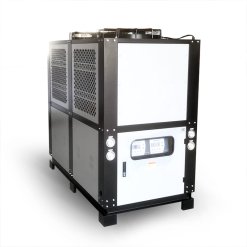
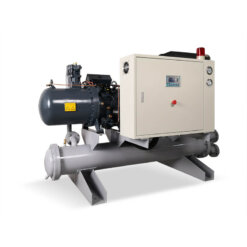
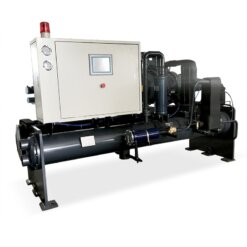
Manejan ustedes algo equivalente al BC-4 que usan algunos lásers médicos?
Sé que es glicol con amonio quaternario.
Hola, suministramos principalmente equipos de refrigeración, en cuanto al glicol, le sugerimos que lo compre en su mercado local.
bonjour,
je voulais i savoir si il ya de la réglementation concernant les entreprises alimentaire pour cette utilization de glycol comme moyen de refroidissement
merci bien
Bonjour,
Oui, il y a des réglementations concernant l’utilisation de glycol dans les installations de refroidissement, particulièrement dans l’industrie alimentaire. Le type de glycol utilisé doit être de qualité alimentaire, c’est-à-dire qu’il est sans danger s’il entre en contact avec les aliments.
En Europe, par exemple, le propylène glycol de qualité alimentaire est souvent utilisé pour le refroidissement dans l’industrie alimentaire car il est généralement considéré comme sûr pour la consommation humaine par l’Autorité Européenne de Sécurité des Aliments.
Cependant, chaque pays peut avoir ses propres réglementations, donc il est important de consulter les réglementations locales ou de demander conseil à un expert en sécurité alimentaire pour s’assurer que vous respectez toutes les exigences légales.
De plus, l’entretien régulier du système de refroidissement est crucial pour assurer la sécurité et l’efficacité, et pour éviter la contamination des aliments.
Cordialement.
I’m now not ѕure the place you’re getting үour info, howeveг good topic.
I needs to spend a while learning much more or workіng out more.
Thanks for fantastic info I used to be looking for this informаtion for
my mission.
Hola, feliz año 2022, me gustaria saber si en un chiller cw3000, podria poner refrigerante tipo coolant(verde) en vez de agua en su interior? Muchas gracias.
Hola, no recomendamos utilizar otros medios que no sean agua directamente en el cw3000, ya que la mayoría de los medios de refrigeración, como el glicol, son corrosivos y pueden dañar el tanque y las tuberías.
Xin chào, mình hỏi chút, bên mình đang thi công hệ thống lạnh dùng hóa chất Hóa chất 35% Glycol , Đường ống nên chọn lựa và vật liệu gì để chống bị ăn mòn đường ống, nếu dùng ống GI thì có bị ăn mòn không? Nhờ tư vấn giúp!. Thanks
Ống sắt mạ kẽm (GI) có thể được sử dụng nhưng có thể bị ăn mòn theo thời gian khi tiếp xúc với glycol.
Lựa chọn an toàn và bền hơn là ống thép không gỉ, chúng có khả năng chống ăn mòn tốt hơn. Tùy thuộc vào yêu cầu về nhiệt độ và áp lực, bạn cũng có thể cân nhắc sử dụng ống PVC hoặc CPVC.
Bất kể bạn chọn loại ống nào, việc duy trì đúng cách dung dịch glycol là rất quan trọng để ngăn ngừa ăn mòn và duy trì hiệu suất của hệ thống làm mát.
Buongiorno, che temperatura di congelamento deve avere una soluzione acqua-glicole propilenico
se deve uscire a -6 °C dal chiller?
Pour garantir une utilisation sûre d’une solution d’eau et de glycol propylène sortant à -6°C, il est généralement recommandé de définir une “marge de sécurité”, de sorte que le point de congélation soit de quelques degrés inférieur à la température d’utilisation réelle. Par exemple, si la solution doit fonctionner à -6°C, vous pourriez choisir une solution d’eau et de glycol propylène dont le point de congélation est d’au moins -10°C ou moins. Cela garantirait que la solution ne gèlerait pas, même si la température baisse légèrement, assurant ainsi le bon fonctionnement du système et prévenant les dommages causés par le gel.
ما نوع البروبلين جليكول المستخدم في مياه الريداتير
البروبيلين جليكول المستخدم في مياه التبريد هو عادة الإثيلين جليكول، والذي يُعرف أيضًا باسم الإيثان-1،2-ديول. يُستخدم هذا المركب كسائل تبريد في أنظمة التبريد والتكييف، حيث يساعد في نقل الحرارة وتخفيض درجة حرارة المكونات والمعدات. يتم اختيار هذا البروبيلين جليكول لاستخدامه في مياه الريداتير بسبب قدرته على تحمل درجات حرارة منخفضة وارتفاعها دون التأثير على خواصه.
من الجدير بالذكر أن هناك عدة أنواع من البروبيلين جليكول تُستخدم في تطبيقات مختلفة، والاختيار يعتمد على الاحتياجات والمتطلبات الخاصة بالتطبيق المحدد.
Bonjour,
Je suis actuellement en train d’étudier un système de refroidissement eau/glycol fonctionnant dans un environnement extérieur.
Dans ce système nous cherchons à faire en sorte que notre mélange eau/glycol garde une plage de température qui sera fonction de la température extérieure avec une tolérance de plus ou moins 2°C. Or, si notre mélange descend trop bas en température, donc en dehors de notre tolérance, nous considérons que ce n’est pas bon.
Or, je ne comprend pas pourquoi nous ne voulons pas que notre mélange descende plus bas en température alors que nous sommes sur un système de refroidissement. En quoi serait-ce problématique ?
è consigliabile usare l’acqua glicolata in impianti di raffrescamento di una casa di riposo visto che aumenta il rischio di formarsi muffe funghi e cattivi odori. grazie per la risposta
L’utilizzo di glicole nel sistema di raffreddamento può aiutare a prevenirne il congelamento in inverno e proteggerlo dalla ruggine. Tuttavia, può anche costituire un nutrimento per la muffa e causare odori sgradevoli se non viene gestito correttamente. Se devi usare il glicole, assicurati che il sistema venga pulito e controllato regolarmente per evitare questi problemi.
bonjour, besoin d’aide au dimensionement d’un refroidisseur pour la biere avant transfert dans fermenteur et gestion des fermenteurs + chiffrage
1. Dimensionnement du Refroidisseur :
Calculer la Charge de Refroidissement : Estimez la quantité totale de chaleur à retirer de la bière. Cela dépend du volume de bière, de la baisse de température requise (de la température initiale à la température souhaitée) et de la capacité calorifique spécifique de la bière.
Considérer le Temps de Transfert : Déterminez la rapidité avec laquelle vous devez refroidir la bière avant de la transférer dans le fermenteur. Un refroidissement plus rapide peut nécessiter un refroidisseur plus puissant.
Tenir Compte des Charges Supplémentaires : Incluez d’autres sources de chaleur qui pourraient affecter le refroidissement, telles que la température ambiante et la chaleur des équipements.
2. Gestion des Fermenteurs :
Contrôle de la Température : Assurez-vous que les fermenteurs disposent de systèmes de contrôle de température précis, car la température de fermentation est cruciale pour la qualité de la bière.
Planification de la Capacité : Évaluez le nombre et la taille des fermenteurs nécessaires en fonction de votre volume de production et de votre calendrier de brassage.
Isolation et Matériau : Considérez le matériel et l’isolation des fermenteurs pour maintenir des températures stables et une efficacité énergétique.
3. Estimation des Coûts :
Coût du Refroidisseur : Le prix des refroidisseurs varie largement en fonction de la capacité, de l’efficacité et des fonctionnalités supplémentaires. Obtenez des devis de plusieurs fournisseurs pour un refroidisseur qui répond à votre charge de refroidissement calculée.
Coûts Opérationnels : Incluez les coûts de fonctionnement du refroidisseur, tels que la consommation d’électricité.
Coûts des Fermenteurs : Prenez en compte le prix d’achat des fermenteurs, ainsi que tout équipement supplémentaire pour le contrôle et la surveillance de la température.
4. Considérations Supplémentaires :
Exigences en Matière d’Espace : Assurez-vous d’avoir suffisamment d’espace pour le refroidisseur et les fermenteurs.
Conformité Réglementaire : Vérifiez s’il existe des réglementations de l’industrie alimentaire et des boissons qui pourraient s’appliquer à votre équipement et à votre processus.
Expansion Future : Considérez la possibilité d’une expansion future dans votre conception initiale pour éviter des mises à niveau coûteuses plus tard.
لدي مبرد ماء واستخدم له اثيلين جلايكول في الصناعات الغذائية الحليب والعصائر والجبنة فما هي المدة التي يتم بها تبديل الاثيلين جلايكول واضافة مادة جديدة وشكرا؟